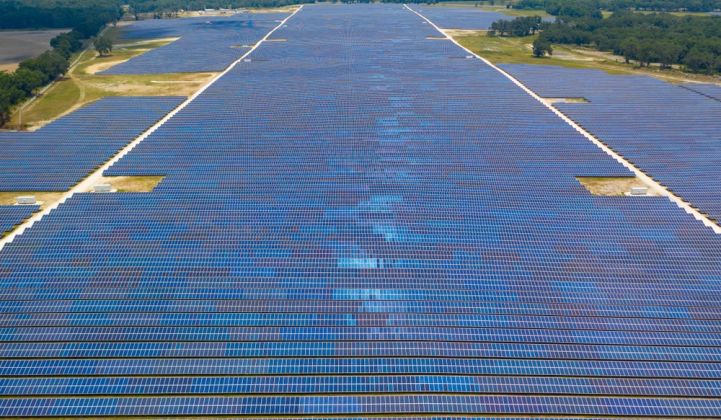The Sunshine State is finally owning its nickname when it comes to large-scale solar energy, with Wood Mackenzie Power & Renewables forecasting 9 gigawatts of utility-scale installations between 2019 and 2024.
That will likely make Florida the top state market for utility-scale projects during that timeframe, knocking off long-time leader California.
But the two states' markets are evolving in quite different ways. Florida's regulated utilities are driving the state's future capacity additions, but they're typically choosing to develop and build projects in-house.
That's pushed third-party solar developers towards the sidelines in one of the country's hottest markets.
Utilities own the market
Florida may lack a renewable portfolio standard, but these days its utilities are pulling the solar market forward anyway.
Tampa Electric has plans for 600 megawatts of solar across its territory by 2021, Duke Florida is working towards 700 megawatts of solar by 2022 and Florida Power & Light, a subsidiary of NextEra that serves upwards of 10 million people in the state, is working on more than 8 gigawatts by 2030.
In Florida, projects under 75 megawatts don’t need the same regulatory approval as larger projects. Utilities can also recover costs on solar investments through the state’s Solar Base Rate Adjustment, approved in 2017, as long as projects come in under a cost cap approved by the utility commission .
Natural gas produces more than two-thirds of the state’s electricity, according to the Energy Information Administration, but utilities say adding solar is now an economic choice. (That's not to say natural gas is no longer on the table for capacity additions).
Those dynamics provide economic and regulatory incentives for Florida’s utilities to move towards solar, and build it themselves. Utilities also point to environmental benefits and customer demand as drivers.
“In Florida, to the utilities' credit, the development of solar has been led primarily by the utilities themselves,” said Sean Gallagher, vice president of state affairs at trade group the Solar Energy Industries Association.
Though California’s renewable portfolio standard has been key to spurring the solar market there, voluntary procurement accounted for 72 percent of total U.S. utility-scale contracts in 2017 and 65 percent of contracts in 2018, according to WoodMac.
Gallagher said the self-ownership trend will grow as more utilities grapple with the energy transition and look to acquire solar. “We’re going to see more and more utilities looking to own renewable facilities."
A tougher ride for developers
Florida’s solar surge hasn’t benefitted all in the industry equally, though. Advocates say the state remains a tricky environment for third-party developers, even as its market balloons.
The combination of utility expertise and economic benefit associated with self-building has resulted in somewhat of a “closed market” for third-party developers, according to Myles Burnsed, vice president of strategic developments at EDF Renewables.
While some utilities say they’re open to working with developers — Tampa Electric told Greentech Media it’s working with Invenergy and First Solar, for instance, and Jacksonville Electric Authority recently signed a deal with EDF — Florida’s utilities aren’t playing solar development catch-up in the way some less-experienced utilities might need to. Florida Power & Light’s parent, NextEra, is among the largest wind and solar developers in the U.S.
“In Florida, we’re a bit unique because we do have NextEra and Duke as two of the big anchors,” said Burnsed. “They’re both very experienced in solar, so they don’t have a learning curve. They’ve been able to just do it in-house.”
That’s helped boost WoodMac’s forecasts, but solar advocates say it creates an unhealthy environment for competition, which can hurt ratepayers.
“For our members it’s a little bit of a mixed bag. … The utilities in Florida are developing these solar installations on their own as opposed to going out to the market for a competitive procurement to return the best price for the utility and their customers,” said SEIA’s Gallagher. “We want to praise the Florida utilities for seeing that solar is the best way forward for the customers, but [also] encourage them to look to the market to get an even better deal.”
The latest data from WoodMac puts utility fixed-tilt system pricing at $0.93 per watt and utility tracking system pricing at $1.04 per watt, quite a bit lower than Florida’s cost caps assigned at $1.50 per watt for Tampa Electric Company and $1.75 per watt for Florida Power & Light,* for example. If utilities were required to sign projects through a request for proposal, Burnsed said it would likely result in more competitively-priced projects.
“The [utilities] are very competent and good solar developers, but it would be a better source of project competition [and] potentially lower rates for in-use customers since the projects are being rate-based,” said Burnsed.
Gallagher also noted the potential for partnerships, with third-parties beginning the development process and utilities buying a project at a certain stage.
“Our efforts in Florida are really about introducing more competition to that market,” Gallagher said, adding that SEIA is currently determining whether the utility commission or the legislature is the best place to lobby for changes.
The most concrete opportunity may come when the Solar Rate Base Adjustment is up for renewal, which each utility pursues separately for new projects. The public service commission will consider a proposal from Duke on July 9. Tampa Electric filed a petition in late June to rate base two projects expected to come online in January 2020.
*An earlier version of this article misstated the units of pricing. It has been corrected.




